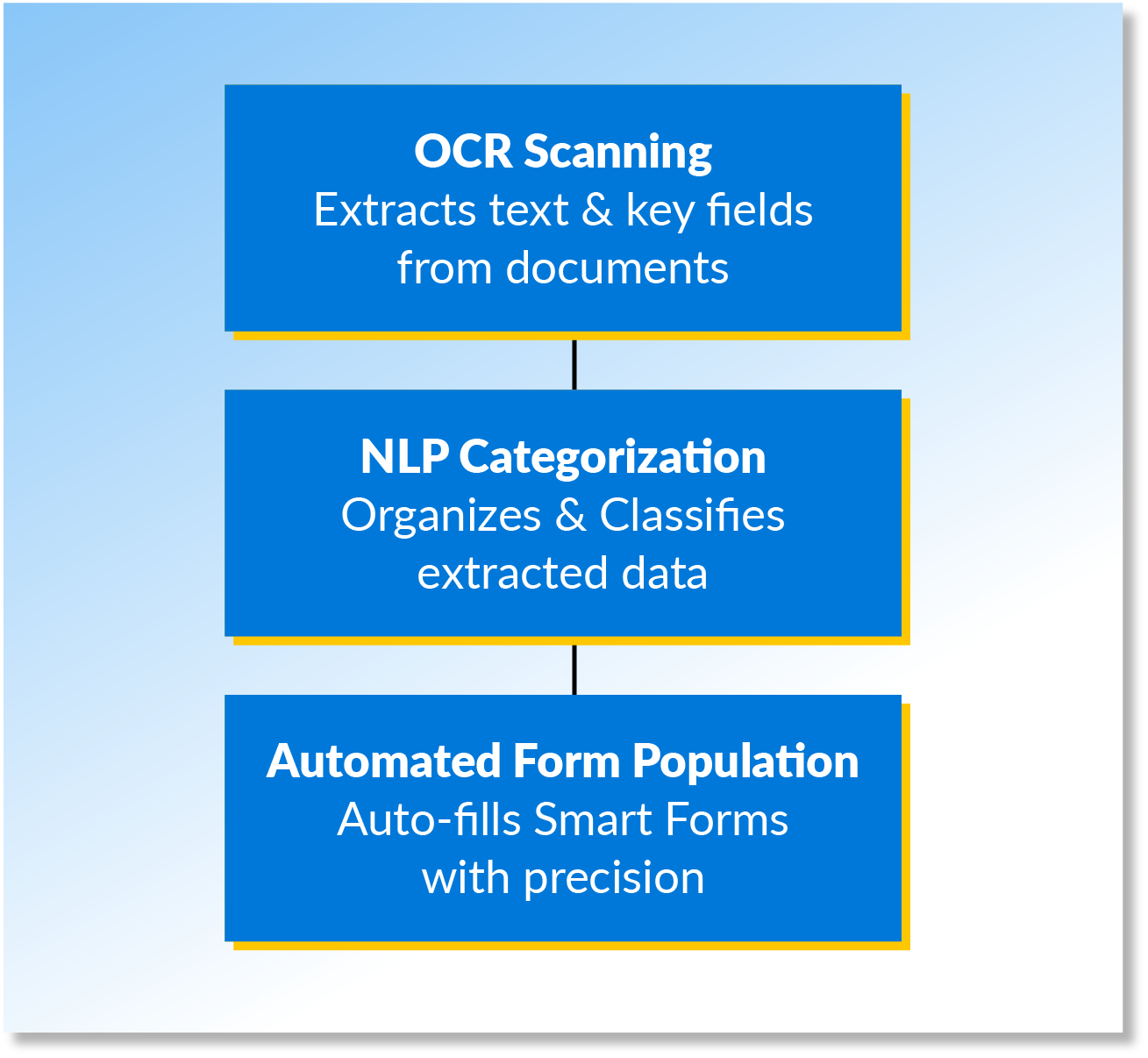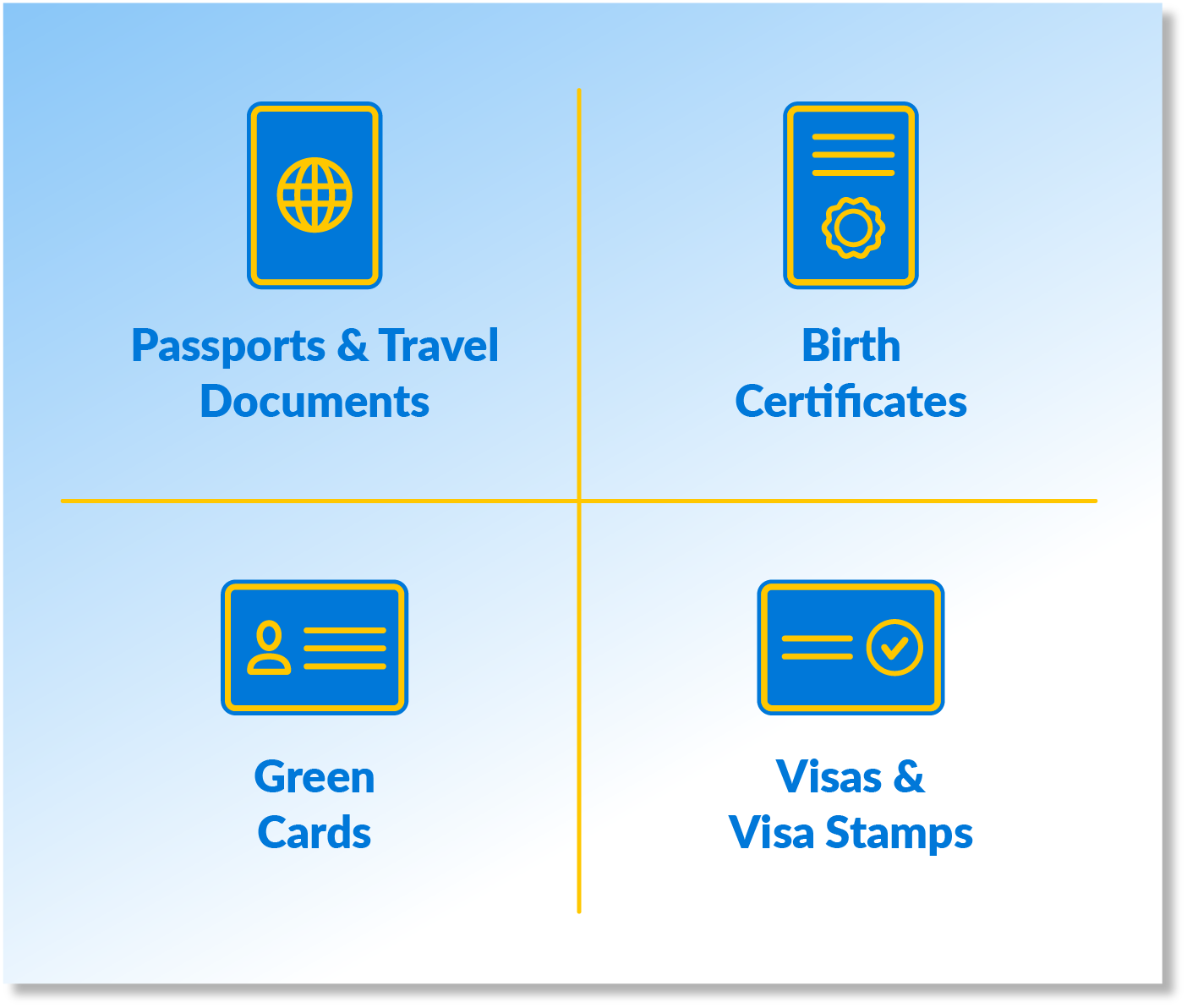Imagine cutting hours of tedious admin work down to just minutes. That’s the power of artificial intelligence (AI) when it comes to document processing. Nowadays, legal professionals are leaning on AI to automate repetitive tasks, eliminate human error, and keep workflows running smoothly. This means that what once required painstaking manual effort can now be done faster, smarter, and with greater accuracy.
For immigration law firms, where complex, document-heavy workflows are the norm, AI document processing offers a game-changing solution. With AI, this means cutting down on hours of manually entering data from visas, green cards, passports, and other critical documents—tasks that are not only tedious but also prone to errors.
In this article, we’ll explore AI-powered document processing, how it works, the challenges it solves, and how immigration firms can leverage AI to automate data extraction and form population for faster, more accurate casework.
Understanding AI Document Processing and AI Document Extraction
AI document processing, also known as intelligent document processing or IDP automation, uses AI to scan, classify, extract, validate, and organize information from unstructured or semi-structured documents. With IDP automation technology, legal professionals and businesses can quickly and accurately process large volumes of documents.
Among the core components of AI document processing, AI document extraction is particularly useful as it focuses on identifying and extracting key data points—such as names, dates, and case numbers—from scanned or digital documents.
Since immigration law firms deal with many physical documents from their clients, AI document extraction can play a vital role in automating form completion, reducing errors, and eliminating manual data entry.
Key Challenges in Manually Processing Documents
Processing documents and paperwork is a critical but time-consuming task in immigration law. Every day, attorneys and their teams manually extract data from legal documents—often re-entering the same information across multiple forms and systems. This inefficiency doesn’t just slow down case preparation, it also increases the risk of human error—leading to costly mistakes and unnecessary delays.
Let’s go over some of the major challenges of manual document processing and how using AI to read documents and process them can help.
1. Repetitive Data Entry
Attorneys and staff spend valuable hours copying details like names, birthdates, and case numbers—time that could be better spent on client advocacy. With AI-powered document extraction, this information is instantly captured and populated into the appropriate fields, eliminating redundant data entry and ensuring accuracy from the start.
2. Client Friction
Clients often find themselves repeating the same information throughout the intake and case preparation process—this back-and-forth not only leads to frustration but can also slow down case progression. AI-driven document processing automation simplifies the intake experience by extracting key details from uploaded documents—reducing the need for clients to fill out repetitive forms and enabling a smoother, faster process.
3. Delayed Case Progress
Every delay in document processing—whether due to manual errors, missing information, or slow data entry—can stall a case. Immigration attorneys are often juggling multiple cases with strict deadlines, and any setback can impact a client’s legal status or timeline. By integrating AI-powered document processing automation directly into workflows, firms can eliminate bottlenecks, keep cases moving forward efficiently, and ensure clients receive timely legal guidance.
AI document extraction doesn’t just automate tedious tasks—it allows immigration attorneys to focus on what truly matters: delivering clear, empathetic guidance to their clients.
How AI Document Extraction Works

AI-powered document extraction follows a structured process to scan, interpret, and organize information from legal documents with high accuracy.
Step 1: Optical Character Recognition (OCR) Scans & Identifies Key Fields
OCR technology extracts text, numbers, and formatting from PDFs, scanned images, and digital forms. For immigration firms, these AI document scanners can scan passports, visas, birth certificates, and green cards to extract applicant details automatically.
Step 2: Natural Language Processing (NLP) Analyzes & Categorizes Information
Using AI document recognition, the extracted text is classified based on document type (e.g., I-94, work permits, and I-130 documents). For instance, the AI document scanner recognizes an uploaded passport and categorizes extracted details under the correct case file.
Step 3: Intelligent Automation Populates Forms
AI automatically fills Smart Forms (e.g., I-130, I-485, I-765) using extracted data, reducing manual entry and errors. For example, when a client uploads their visa, the system extracts and auto-fills the relevant details into the appropriate immigration form.
Benefits of AI-Powered Document Extraction for Immigration Firms
Implementing AI document extraction can significantly improve efficiency, accuracy, and client experience for immigration law firms. Some of the top benefits of leveraging intelligent document processing include:
1. Time Savings
By automating data extraction, firms can process a higher volume of cases while freeing up staff to focus on legal strategy and client communication. Automated data capture can instantly extract key information instantly from uploaded passports and green cards—giving you the information you need in a matter of seconds.
2. Increased Accuracy
Utilizing AI document recognition minimizes human errors, ensuring that case data is precise and reliable. When it comes to filling out immigration forms, this can be invaluable. For instance, a solution like Docketwise IQ allows data to flow directly into Smart Forms, eliminating repetitive input and reducing costly mistakes.
3. Better Client Experience
A smoother, faster intake process leads to higher client satisfaction and a stronger firm reputation. With a streamlined intake process, like what’s provided by Docketwise, essential details can be pre-populated, making it easier (and faster) for clients to complete their paperwork.
Immigration Documents that can be Extracted with AI

AI-powered document processing is particularly useful for extracting data from scanned, non-digital documents, including:
Passports & travel documents:
Extracts names, birthdates, nationalities, passport numbers, and visa stamps.
Birth certificates:
Captures name, birthdate, place of birth, and parental details for family-based immigration cases.
Green cards:
Extracts A-numbers, expiration dates, and category codes for status adjustments and naturalization.
Visas & Visa stamps:
Recognizes visa types, issue dates, expiration dates, and issuing consulates for verification.
Docketwise’s AI Data Capture Transforms Immigration Firms
In immigration law, accuracy and efficiency are everything—one small error or delay in document processing can impact a client’s legal status. By leveraging AI document extraction, immigration firms can streamline document management and ensure accuracy in their filings. But which is the best intelligent document processing software for your firm? A trusted and reliable solution can make all the difference.
Docketwise is designed specifically for immigration attorneys—for example, Docketwise’s AI document capture seamlessly integrates with Smart Forms to streamline case processing. With instant data extraction from passports, green cards, and other legal documents, it eliminates the need for manual entry—reducing errors and saving hours of time. Additionally, AI-powered automation makes client intake more efficient—once documents are submitted, the system populates all necessary fields automatically, quickly, and accurately.
Interested to see how Docketwise IQ can enhance your immigration practice? Learn more about the powerful features here.
About the author

M.E. Hammond
